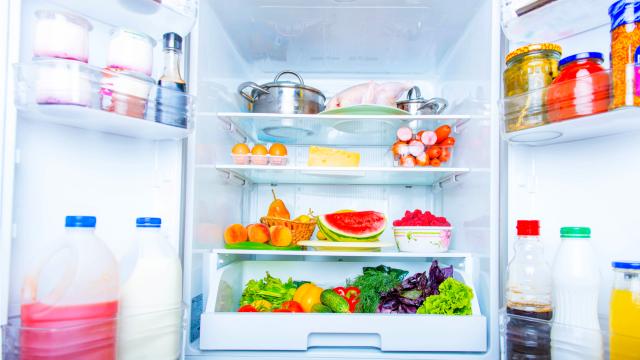Have you noticed your milk getting frosty? Meat spoiling quickly? It’s likely your refrigerator is set to the wrong temperature. It’s recommended you keep your refrigerator at or below 4° C, and your freezer at -18° C to keep your food fresh the longest and prevent the growth of bacteria that could cause food-borne illnesses. Here are some more tips to help you ensure your perishables don’t perish.
Get a fridge thermometer
“I never trust an appliance’s self-reporting temperature; I’ve had enough ovens with hot spots to always be wary,” advises a user on the food safety forum at Stack Exchange. “With our fridge, our crisper drawer regularly frosts and partially freezes our veggies, and with a thermometer I was able to determine why: it’s significantly colder down there than the 1.6 degrees Celsius the rest of the fridge is set on. By at least 5-8 degrees.” Move the thermometer around to check for cold and warm spots, and arrange your food accordingly.
Keep your refrigerator full
If you’re opening your refrigerator and freezer regularly, then keeping them stocked may help keep the temperature consistent. “With an empty fridge, every time you open and close the door you cycle most of the air in it, replacing the cooled air with warmer air, which has then to be cooled again,” say fridge enthusiasts on The Naked Scientists. “With a full fridge, there’s not only less air to be cycled and re-cooled, all the other items that have been cooled stay in the fridge. The presence of many items in the fridge may also reduce the airflow, meaning even less air is exchanged each time the door is opened and then closed.”
But don’t overstuff it
Keeping the fridge/freezer full is more efficient, yes — but packing it too tightly will restrict circulation and air flow, ultimately forcing it to work harder to keep things at the right temperature, according to Hunker. Another risk: jamming too much in the fridge can block air vents, leading to a host of temperature and moisture issues, and potentially causing some foods to spoil more quickly.
Check the air vents
To expand upon that last point: Air needs to pass unimpeded between the freezer and refrigerator in order to keep the temperature steady. If you’re seeing frost in your fridge, make sure there isn’t a wayward loaf of bread stuffed up against the air vent, preventing circulation. You should be able to find a guide for your particular refrigerator model online.
Avoid the ‘danger zone’
If you want to ensure your food isn’t developing harmful bacteria that may make you sick, keep it out of the cold-but-not-cold-enough “danger zone” in which bacteria thrive. According to Good Housekeeping, the ideal fridge temp is between 1.6° C and 3.3° C.
Know your fridge’s naturally coldest areas
“The temperature within your fridge can vary rather significantly with normal usage,” says Stack Exchange’s hobodave. “The coldest parts of your refrigerator are the back, and the bottom. The back because the cooling element is there, and the bottom because warm air rises. If items you don’t want frosty are getting frosty, then move them away from the back of the fridge.”
Don’t put spoil-prone items in the door
The fridge door is likely to be one of the warmest areas of the fridge, and a spot where the temperature fluctuates the most — so don’t store anything likely to spoil there. “The items in the door of your fridge can easily get as high as 15 C, and do so often,” says hobodave. “Putting milk and eggs in your door will significantly decrease their shelf life.” In fact, speaking to Well and Good, dietitian Lisa DeFazio recommends never storing milk, eggs, dairy or meat in the door. Instead, keep those items toward the rear of the fridge, where temperatures are colder and more stable.
This story was originally published in June 2013 and was updated on October 23 with more detailed information and a new header image.

Leave a Reply
You must be logged in to post a comment.